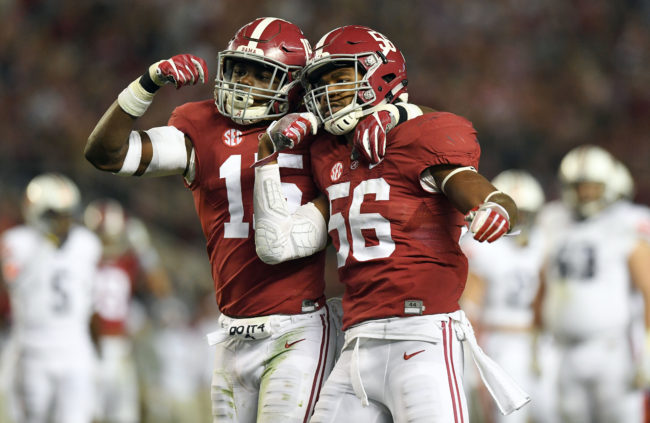
Alabama’s defensive versatility will play key role against Washington in Peach Bowl
ATLANTA — A dominant defense has been the main ingredient in Alabama’s championship recipe over the years, and that is no different in 2016.
Unlike the big, physical units from two or three years ago, however, this year’s Crimson Tide defense is Nick Saban’s most versatile and fluid. The 2011 Alabama defense imposed its will on opponents through brute force but could be susceptible to up-tempo passing attacks. Over the past two years, the Crimson Tide have traded in some of that bulk and become a smaller, faster defense.
The result is a group that has become much harder to exploit through single matchups. Every level of the defense can do a variety of things well, which makes it difficult to find a major weakness. Saban adapted to a new brand of football, and his defense is all the more lethal.
Despite the decision to scale down in size, Alabama’s defense has maintained its imposing demeanor and aggressive style of play. It ranks fourth nationally with 45.0 sacks after leading the nation in 2015 with 52.0 in 15 games.
Senior linebacker Reuben Foster summed it up perfectly when addressing the media on Tuesday at a Peach Bowl press conference.
“We lost the weight, but we didn’t lose the mentality,” Foster said.
Washington is capable of testing Alabama’s defensive versatility. The Huskies have some particular skill sets that allow them to employ different strategies.
Their attack starts with quarterback Jake Browning, who can make any type of throw. He can stretch the field vertically, as he did in a 6-touchdown, 378-yard performance against Cal, or he can turn in an efficient performance while going through his reads as he did at Oregon. Browning, 6-2, 209 pounds, isn’t a running threat, but he can buy time in the pocket and make throws on the run.
Edge players like Tim Williams (below) and Ryan Anderson will be important in the Tide’s efforts to keep tabs on Browning and they have the speed to do so.

Jerome Miron-USA TODAY Sports
Speed on the perimeter of Alabama’s secondary will be of the utmost importance, though. Washington wide receiver John Ross has game-breaking speed and is a legitimate playmaker. He is tied for third nationally with 17 touchdown catches and has had a 50-yard reception in four games this season.
He will give the Crimson Tide defensive backs all they can handle. Ross, 5-11, 190 pounds, isn’t just a vertical threat, however, he operates extremely well in space, which means Alabama’s linebackers will need to be prepared as well.
This is one aspect where the Tide’s versatility is so valuable. Before deciding to get smaller, a player like Ross could have run rampant against Alabama’s linebackers and bigger defensive backs. Now, they have the quickness to help counter his speed and agility.
Huskies’ running back Myles Gaskin is a prime example of the team’s offensive versatility. The 5-foot-10, 195-pound back has lateral quickness, top-end speed and a low center of gravity that complements his tremendous balance. He’s just as likely to bounce off a tackle as he is to avoid a defender in the backfield and find the hole for a 60-yard touchdown.
Washington typically tries to establish the run, and that no doubt will be a challenge against the nation’s top run defense.
Alabama’s swarming mentality on defense should prove to be effective against a player like Gaskin, but it’s the moments when he’s one-on-one in open space that will be important. Each level of the Tide’s defense is equipped to match his speed and physicality.
Browning, Ross and Allen are Washington’s three biggest stars, but the Huskies also have outstanding complementary pieces. Receiver Dante Pettis, 6-1, 188, is another deep threat who locates the ball well, has excellent hands and controls his body smoothly in the air. He has reeled in a 30-yard catch in seven games and has 14 touchdown catches.
The Huskies’ skill players are among the most talented that Alabama has played, but the Crimson Tide do their most damage along the line of scrimmage. Washington’s offensive line doesn’t have the size of an SEC unit, but defensive end Dalvin Tomlinson noted something it does have.
“(Washington’s) offensive line is a lot quicker than those that we have faced this year,” Tomlinson told reporters at Tuesday’s CFP press conference.
The quickness might have been a problem for Alabama’s bigger defenses, but the Crimson Tide have the speed to match. There are few weaknesses on Alabama’s defense, and virtually none on the line, which is stacked with NFL prospects. Washington’s front five allow just 1.62 sacks per game, but it will take their best performance to slow down the Tide’s pass rushers.
The key to this game might be whether Browning can get the ball to his talented receivers before Alabama’s rush can get to him.
Doing so will help negate Washington’s speed on the perimeter and prevent its backs from getting any momentum past the line of scrimmage. Of course, good line play has been a staple of every Saban defense.
What makes this one more dangerous is its ability to match up at every level should the defensive line have a tough time getting its job done.
William McFadden covers the University of Georgia and the University of Alabama for Saturday Down South. For insight on these two SEC powerhouses, follow him on Twitter @willmcfadden.
